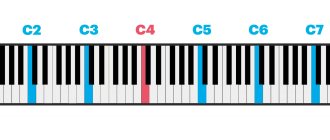The topic of this lesson is timbre and pitch of the voice. At the beginning of the course, we studied all the basic properties and characteristics of the voice in general, and we devote subsequent lessons to a more detailed acquaintance with each of them.
Today we will take a closer look at such characteristics of the voice as pitch and timbre. The goal of our lesson is to learn how to control the pitch and timbre of the voice, convey various emotions using pitch and timbre, and make accents with the voice.
In this lesson we will study different types of timbre, the dependence of voice pitch on timbre, and understand how to use this in practice.
Our tasks are clear, so let's go!
Properties of professional vocals
There are 8 octaves within which singers perform songs and arias. Each performer has his own range - the distance from the lower notes to the upper ones that he can sing. A professionally trained voice easily creates homogeneous sounds within two octaves. This is considered a good range for a music career.
There is a distinction between the full range - those notes that the singer can hit, and the working range - in which he is comfortable singing. An important characteristic is the timbre of singing voices, they are:
- soft;
- sharp;
- head;
- chest;
- mixed.
The quality of flight is important for the performer - such a voice can be heard without a microphone. It appears when there are high overtones in the voice, which impart smoothness and sensuality. Another quality of the operatic voice is strength, because the singer must solo against the background of music performed by the orchestra.
The vocal apparatus of men and women operates in different registers, producing sounds that are uniform in timbre. The female voice has the following registers:
- head - located in the upper range part;
- chest;
- central - combines chest and head sounds.
In male performance, musicologists distinguish two registers: chest and falsetto. The first is characterized by a rich sound and is located at the bottom of the range, and the second is weak and is located at the top.
For professionals, the transitions between registers are smoothed, and in order to sing naturally and hit high or low notes, the singer must have a reserve of musical and physiological capabilities. In addition, male and female singing voices are divided into groups.
Voice classification
Types of singing voices can be classified according to different parameters. The first attempts to implement this were made in the 12th-13th centuries. The currently accepted characteristics of singing voices took shape in the 14th century. with the development of polyphonic choral singing. That's when they were divided by performer's gender and range. At first there were 4 main voices accompanying the music - two male and two female (bass and tenor, soprano and alto).
The increasing complexity of the repertoire led to a more detailed differentiation of voices, which first appeared in the Italian opera school. The characteristics took into account tonality, timbre, working range, tessitura (comfortable singing zone).
Trust your feelings
Many professional groups are overflowing with performers whose singing voices correspond to the level of mezzo-sopranos who are able to embody their talents in other categories, and this depends on the quality of technique and level of education.
A feeling of tension in singing signals that the range has been chosen incorrectly, and such performance has a destructive effect on the ligaments. When a singer experiences a feeling of lightness, freedom, and pleasure from his own performance, this means that the performer is on the right path, and distant horizons are within his control.
Women's singing
Depending on the timbre coloring, female voices are divided into 3 main groups - soprano, mezzo-soprano, contralto. They differ in lightness, transparency, strength and richness of sound.
Singers whose range and tessitura are unusually wide become legends. One of the most famous performers is Ima Sumac from Peru. She sang soprano and contralto easily, using 5 octaves.
Soprano differences
This is the highest voice, singing the note C from the first to third octave. Such vocals are distinguished by transparent lightness, sonority, open, mobile sound, and flight. Due to the variety of performing capabilities, sopranos are divided into several varieties:
- Coloratura. The name comes from the Italian word for "over". Distinguished by the ability to perform fast and complex passages and graces, melismas, roulades. It sounds from C of the first octave to F of the third octave, and can be supplemented at the top of the range with a brilliant fourth or fifth. Such a voice easily captivates with its purity and sonority, resembling a violin or flute. It does not merge with other voices, therefore it is practically not used in choral singing, and its timbre is the basis for selecting other performers. Many wonderful roles have been written for coloratura sopranos: Violetta (La Traviata), Queen of the Night (The Magic Flute), Antonida (Ivan Susanin), Lyudmila (Ruslan and Lyudmila). Modern opera divas A. Georgiou, Y. Lezhneva, A. Patti, Evgenia Miroshnichenko sing coloratura soprano.
- Lyric coloratura. They are classified as a separate type due to their melodiousness and technical agility, which allows the voice to merge with the choir. The midrange is stronger than in a coloratura soprano. Takes the range from C first octave to E third. Among the singers, Sumi Yo and N. Dessey became famous.
- Lyrical. It sounds bright in the upper register, reaches the note E of the third octave, the timbre is soft, light, silvery. In the second octave it resembles the sounds of an oboe. G. Vishnevskaya, M. Freni, B. Nilsson, M. Caballe, A. Netrebko have lyric sopranos. The roles of Mimi (La Bohème) and Tatyana (Eugene Onegin) were written for this singing voice. Sounds good in a choir.
- Lyrical-dramatic. The rich chesty timbre allows you to perform a variety of roles: Maria (Mazeppa), Tosca in the opera of the same name by G. Puccini. Performers - M. Callas, L. Marshall, R. Tebaldi.
- Dramatic. A thick, powerful voice allows you to demonstrate emotional uplift. It is distinguished by the richness of the middle and lower registers; its owners are able to produce mezzo-soprano sounds. Perfectly distinguishable against the backdrop of orchestral accompaniment. Typical roles are Aida (“Aida”), Lisa (“Queen of Spades”). Singers - M. Gulegina, M. Callas, G. Yanovits.
Composers prepare the roles of young girls or fairy-tale creatures for those with a soprano voice.
Features of the mezzo-soprano
The working range of this female voice ranges from the note A of the small octave to the A of the second. Distinctive features are saturation in the middle registers.
The overall impression of the vocals is depth and even some heaviness of the sounds. Those with a mezzo-soprano voice can sing contralto or soprano roles. In operas they often play the roles of young people, the so-called trouser parts. Mezzo-soprano can be high (lyrical) or low (dramatic). Some experts also distinguish the coloratura mezzo-soprano.
The most famous role for mezzo-soprano of the dramatic type is Carmen from the opera of the same name by J. Bizet. Also written for this unusual voice are the roles of Siebel (Faust), Cherubino (The Marriage of Figaro), Laura (The Stone Guest). Usually these are the roles of strong, brave and strong-willed women. Among the famous performers are M. Kozhena, E. Obraztsova, T. Sinyavskaya.
Contralto sound
Contralto operates in the range from small octave E to F second. This is a low voice in women. Distinctive qualities are full, dense notes in the small octave and resonance in the middle register. The upper register is small, but the low notes sound great, bringing the female voice closer to the male tonality.
The voice is very rare; not all opera houses have performers with such vocals. Composers created roles for young men for contralto, for example, the roles of Vanya in Ivan Susanin and Orpheus in Orpheus and Eurydice. Famous female roles are Olga (“Eugene Onegin”), Marie (“The Flying Dutchman”), Lucia (“Rural Honor”). Singers with contralto voices are E. Poldesh, M. Anderson.
Diction or vocalization
Diction is associated with the ability to be understood and with his desire to be understood.
Clear diction: clarity of mind, openness to communication. Inaccurate: deception or confusion. Very clear: narcissism, tension. Stuttering: aggressiveness, inhibition.
Speed
The speed of conversation speaks about a person’s emotional state.
Slow: lack of interest, disconnection from the world. Quickly: tension, desire to hide information. Regularly: restrained, unnatural. Irregularly: confusion, anxiety, communication breakdown.
Male performance
Experts divide the vocals of the strong half of humanity into tenor, baritone and bass groups. This corresponds to high, middle and low registers. Each group has a more detailed gradation, which takes into account timbre, sound, lightness, and features when playing the upper and lower notes of the range.
In the world of music, not long ago there was a real discovery that cannot be imitated - this is the Kazakh performer Dimash Kudaibergenov, who works in 6 octaves.
Tenor group
This is a popular and beautiful male voice, capable of taking “royal C” in the upper octave. The range is very wide and covers octaves from minor to second. A distinctive feature of tenor soloists is a strong upper register. There are several high-pitched voices in this group:
- Tenor altino has the highest notes to F of the second octave. Rare voice. The timbre is light, light, with silvery top notes. Part of the Astrologer in the opera The Golden Cockerel.
- Lyrical. Performers work in the range up to the first octave - B of the third octave. The voice is mobile, with graceful light coloraturas, the sound is melodious, carefree, warm. Typically, musicians with such abilities perform arias of hero-lovers (Lensky in Onegin, Count Almaviva in The Barber of Seville).
- Characteristic. Has a sound effect, such as a slight ringing of bells or a silvery tone. Indispensable for creating a bright, memorable image.
- Dramatic (sometimes distinguished as lyrical-dramatic). More dense and dynamic in the lower register, and sounding strong and powerful in the upper register. Such metallic-tinged vocals perfectly convey the drama of events. May not take the upper C. The composers created the roles of Herman (The Queen of Spades), Calaf (Turandot), Othello (Othello), and Manrico (Il Trovatore).
- Countertenor. Sounds like a mezzo-soprano. The ability to sing in a developed falsetto technique is valued in the music of the Baroque period.
- Baritone tenor. It is located on the border between tenor and baritone, but the upper range part is less developed. Mime part (The Ring of the Nibelung).
Many wonderful classical opera roles have been written for tenors by Russian and foreign composers: Gounod (Faust), Jose (Carmen), Prince (The Love for Three Oranges). Famous tenors - P. Domingo, M. Lanza, E. Caruso, S. Lemeshev, I. Kozlovsky, E. Pavarotti, L. Sobinov.
Baritone Characteristics
The average male voice captivates with its velvety sound and ability to demonstrate dramatic emotional intensity. The range of baritone singing voices covers from A of the major octave to the next A of the first octave. The baritone is conventionally divided into the following types:
- Lyrical. It is close in timbre to the tenor, but has a peculiar dense tone and high tessitura.
- Lyrical-dramatic. The brightness of the sound, rich timbre and strength allow performers to take on a variety of roles.
- Dramatic. Sounds powerful in the upper range and central register. The sound is dense and dark. It differs in that it has a low tessitura, but at the climax it easily hits the extreme notes. Opera characters performed by a dramatic baritone are always strong personalities, positive or negative.
- Bass-baritone. Some experts distinguish it as intermediate between bass and baritone due to the intense sound in the central register of lower notes that are more massive than those of a regular baritone.
The baritone roles do not leave anyone indifferent - these are Eugene Onegin in the opera of the same name, Prince Igor (“Prince Igor”), Andrei Bolkonsky (“War and Peace”), Aleko and Iago (“Othello”), Demon (“The Demon”). Famous baritones - G. Pray, D. Hvorostovsky, T. Hampson, V. Skorobogatov, V. Petrov.
Types of Bass
The bass voice has the greatest amplitude of sound vibration, so it can more dynamically indicate contrasts when singing. A low voice in men is very rare, so such vocals are indispensable in church choral singing. It is distinguished by rare beauty, depth, and richness of sound.
Bass is submissive to notes in the range from F of the major octave to F of the first. There are 4 types of bass voices:
- High (cantata). Reaches F of the first octave. Reminiscent of a baritone bass, it sounds bright and strong, but is soft and compact in the upper and midrange.
- Central. Performs high tessitura notes, as well as low notes up to F of the large octave. The voice sounds full and spacious, the timbre is beautifully filled.
- Low (profundo). It is distinguished by a velvety timbre and rich color; low notes sound unusually strong right up to the D of the first octave. They are not characterized by grace and passages.
- Octavists. Such performers use the lower register up to the counter-octave note. The voices are inactive, dense, heavy. This type of singing is practically not used in modern opera.
Some experts believe it is appropriate to distinguish bass voices by timbre and distinguish baritone, characteristic, deep, comic.
Composers create musical parts specifically taking into account the sound characteristics of bass voices, because some hum like bells, others are heard harshly, and others give a long peal. For this reason, the characters performed by the singers are also different - these are majestic heroes, respected fathers of families, and funny grotesque images.
Famous roles include Susanin (“Ivan Susanin”), Melnik (“Rusalka”), Moroz (“Snow Maiden”), Sea Tsar and Varangian Guest (“Sadko”). The owners of such voices are I. Petrov, Yu. Statnik, F. Chaliapin, B. Shtokolov, Jose van Dam.
Vocal abilities in children
Children's voices sound higher than adults'. This is explained by the fact that the vocal muscle in a child under 11-13 years of age is not fully formed. Children's vocals are classified according to their range, regardless of the gender of the child:
- alto - low notes;
- soprano - high notes.
A boy's thin child's voice is called a treble and is divided into low, medium, and high. During the process of mutation of the vocal apparatus, the vocal abilities in children change and may completely disappear.
Take a hearing test online
What does a hearing test tell you?
An online hearing test allows you to quickly and easily determine your hearing status. In just 3 minutes you can determine its spiciness. The result of the hearing test is called an “audiogram” and is an indication for doctor’s prescriptions.
We suggest the following hearing tests: signs of hearing loss; online frequency hearing test; hearing test in noise; speech recognition; modeling signs of hearing loss.
Take a hearing test
Exclusive on stage
Sometimes singers are so professional that they are able to perform parts with different characters. Such votes are usually called “absolute”.
For example, the famous singer Maria Callas was able to master all soprano roles - from dramatic to coloratura. Her appearance on stage in exquisite outfits and furs caused a sensation. But such opportunities open up only to unique voices with careful development of sound techniques.
It is almost impossible to determine the type of voice of a beginning singer, since the degree of range and timbre change during training.
Read more on the topic “Useful information about hearing”
Why you don't need a hearing aid
The Academy of Hearing has been working with people suffering from hearing loss for over ten years. During this time, we have collected a whole collection of rumors, myths and misconceptions that surround this disease and the means of its correction - a hearing aid. We collected the most popular ones and asked our experts to comment on them in an easy, understandable and ironic way of “bad advice.”
Tinnitus: causes, treatment methods, consequences
Tinnitus is a widespread phenomenon and one of the most common diagnoses in the practice of treating ENT diseases. In 1999, in Germany, on behalf of the German League of Physicians, a large study was conducted in the field of auditory acoustics, during which it was found that tinnitus entails psychosomatic disorders such as sleep disturbances, depression and increased audiological stress.
How often should you change your hearing aids?
Do you remember what feelings and emotions you experienced when you first put on your hearing aid? How much brighter and more fulfilling has your life become, filled with clear sounds and voices? If several years have passed since then, are you sure that your hearing is still as good? Often, people who use hearing aids begin to notice over time that they begin to hear “somehow differently.”
Hearing aid or hearing amplifier: making the right choice!
Typically, a person loses their hearing gradually. First, the quietest, most inexpressive sounds and subtlest nuances “disappear.” Because of this, it is difficult for a person to ascertain a change in his ability to hear. Quite often, people try to ignore minor hearing loss until the truly important sounds for everyday life, such as the cry of a child or the sound of a car approaching, begin to disappear from the range of audible sounds.







